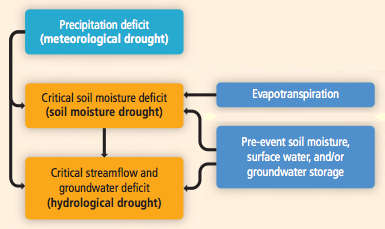With the past few posts looking at floods,
let’s now move on to the next category of natural disasters – droughts. Droughts
are generally defined as ‘a period of abnormally dry weather long enough to
cause a serious hydrological imbalance’ (IPCC 2012). Droughts have been a
relatively common phenomenon in several regions including Australia, Sahel,
North America, and even the United Kingdom (though they are generally much less
severe than those experienced in the other countries mentioned). In fact, since
2012, North America has been hit with one of its worst droughts, with 81% of
the contiguous United States being covered with at least abnormally dry
conditions (DO) at its peak on July 17 2012 (Fig.1). Currently, the situation
has improved significantly although the western parts of the US are still
affected by the droughts (Fig.2).
 |
| Figure 1 US drought monitor report for July 17 2012. 81% of the contiguous US is affected by at least abnormally dry conditions. Source: http://droughtmonitor.unl.edu/ |
 |
| Figure 2 US drought monitor report for December 10 2013. Most of the western part of the US is still affected by the drought. Source: http://droughtmonitor.unl.edu/ |
When discussing about droughts, it is important
to note that there are different types of droughts – meteorological,
hydrological and agricultural (Fig.3). The definitions for each category of
droughts are taken from Mishra and Singh (2010):
- Meteorological – lack of precipitation over a region for a period of time.
- Hydrological – a period with inadequate surface and subsurface water resources for established water uses of a given water resources management system.
- Agricultural – a period with declining soil moisture and consequent crop failure.
 |
| Figure 3 Links between the different types of droughts and the main drivers for the droughts. Source: IPCC SREX report (2012) |
However, out of all the atmospheric hazards, droughts
are at the moment the least well-understood and predictable (Mishra and Singh 2010).
There are still large uncertainties involved regarding observed global-scale
trends in droughts as well as how anthropogenic climate change will affect droughts
in future (IPCC 2012).
Firstly, there has been a lack of consensus
with regards to the observed trends in drought over the recent past. This is
mainly due to the fact that there are few direct observations of
drought-related variables available for global analysis and hence drought
indices, which attempt to integrate precipitation, temperature and other
variables, are used instead to infer the changes in drought conditions. One of
the most prominent index used is the Palmer Drought Severity Index (PDSI)
(Palmer 1965) that measures the cumulative departure in surface water balance.
Based on this index, Dai et al. (2004) have suggested that globally, very dry
areas have doubled in extent since 1970. However, such studies based on the
PSDI have been criticised greatly due to the fact that the PSDI relies on a
temperature-based method of calculation of potential evaporation (PE), known as
the Thornthwaite equation. Sheffield et al. (2012) argued that temperature-based
PE tend to overestimate the extent of drought as it does not factor in the
effects of radiation, vapour-pressure deficit and wind speed. By using a
physically-based estimate of PE based on the Penman-Monteith equation instead, Sheffield et al. (2012) showed that there has actually been little
change in drought over the past 60 years (Fig.4). As such, due to the lack of direct
observations of drought, it has been difficult to determine the global trends
of droughts. The IPCC SREX report (2012) could at best conclude that there is only
a medium confidence that some regions of the world have experienced more
intense and longer droughts since 1950s.
Secondly, there are also large uncertainties
involved with our understanding of how climate change will affect droughts in
the future. There have been preliminary studies based on model simulations that
suggest that aridity increases and because severe by the 2060s over most of
Africa, southern Europe, Middle East, most of Americas, Australia and Southeast
Asia, while central and northern Eurasia, Alaska and northern Canada and India
become increasingly wetter (Fig.5) (Dai 2011). Such results broadly correspond to the
modelling results by Hirabayashi (2008) that suggest that drought frequency from 2070 to 2100 increases over North and
South America, central and southern Africa, the Middle East, southern Asia and
central and western Australia. Meanwhile, the eastern part of Russia shows
significant decreases in drought days due to increases in precipitation and
flood flows.
However, these projections do not consider the impacts of changes
in large-scale atmospheric and ocean circulations under climate change as there
is insufficient knowledge of how these have an impact on droughts. Moreover, it
is also not known how the behaviour of plant transpiration, growth and water
use efficiencies will change under increasing CO2 emissions, which
would consequently affect soil moisture storages (IPCC 2012). Therefore, unfortunately, it is still
hard to determine how trends in droughts will evolve in the future under
climate change.


No comments:
Post a Comment